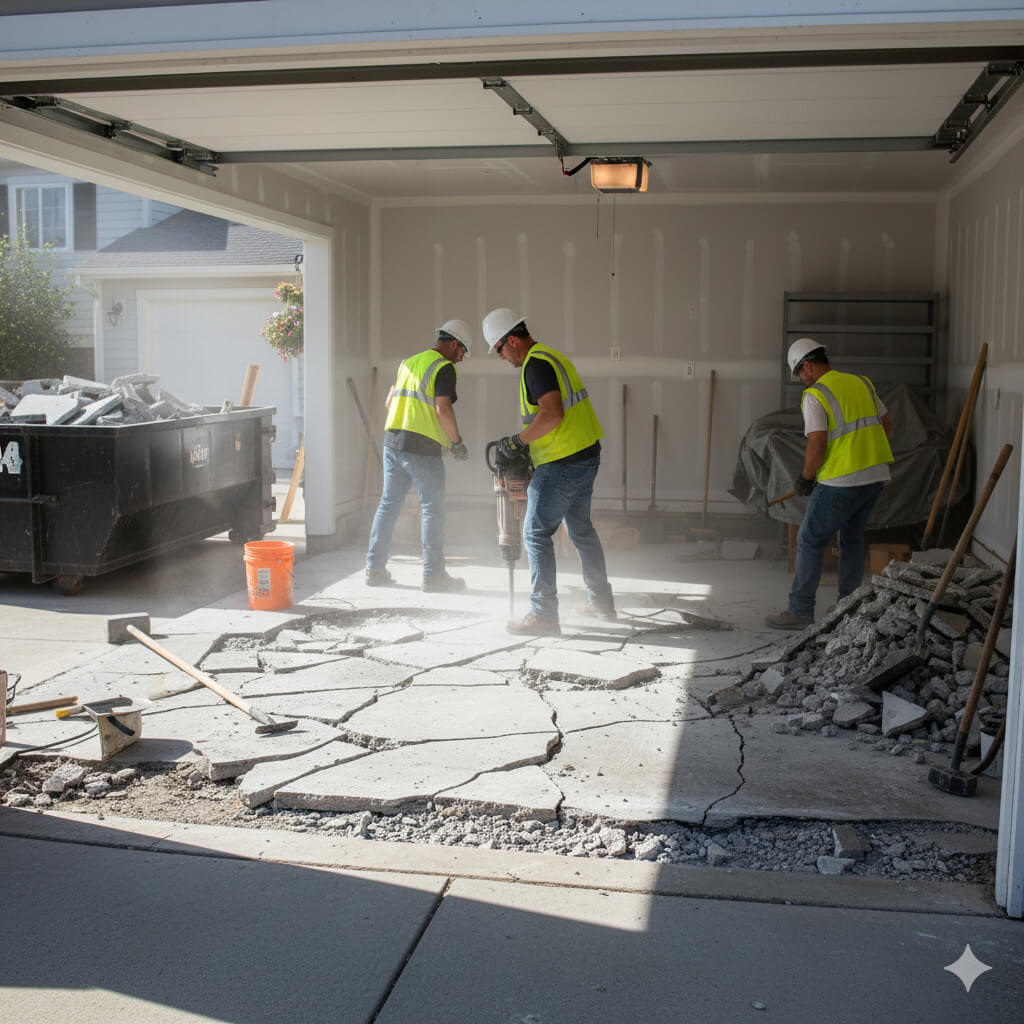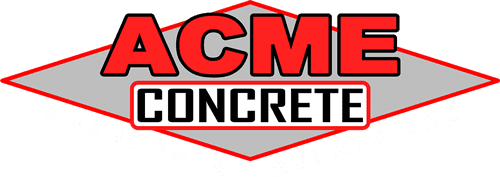
Homeowners in the Chicago suburbs weigh garage floor tear-out against fixing the slab they already own. This guide explains real replacement costs (now $12–$18 per sq ft), the unique challenges of demo inside an enclosed structure, and when polyurethane leveling is the faster, cleaner solution.
Key Takeaways (Garage Floor Replacement Q&A)
What is the concrete garage floor replacement cost in Chicago?
Typical quotes run $12–$18 per sq ft. One-car garages usually fall around $2.9k–$5.4k, two-car $4.8k–$9k, and three-car $10.4k–$23.3k, depending on thickness, access, and reinforcement.
When is leveling better than replacing a garage floor?
If the slab is intact but settled, polyurethane leveling lifts and supports it quickly with minimal mess. Severe fractures, major heave, or a full layout/slope change indicate replacement.
Does spalling/chipping mean I must replace the floor?
Not usually. Spalling/chipping is typically cosmetic from salt and freeze–thaw; consider maintenance and sealing first. Replacement is reserved for structural failure or design changes.
How long is a garage out of service?
A new pour needs days before vehicle traffic and weeks to fully cure. Polyurethane lifts cure in roughly 15–30 minutes, so most garages return to use the same day.
Garage Floor Replacement Cost in Chicago vs Leveling
What drives replacement cost (and why the range exists)
Across Chicagoland, full tear-out and replacement typically lands between $12 and $18 per square foot. That total reflects demolition and haul-off, subgrade regrading/compaction, and a new 4–6 inch slab with reinforcement (wire mesh or rebar). As a quick size guide:
One-car (≈240–300 sq ft): $2,900–$5,400
Two-car (≈400–500 sq ft): $4,800–$9,000
Three-car (≈864–1,296 sq ft): $10,400–$23,300 (approx.)
High-spec surface finishes (like epoxy or polyaspartic) are additional, commonly $5–$12 per sq ft after the new slab cures. Expect the upper end of the range where access is tight, reinforcement is heavier, or drainage details are added.
The hidden challenges of tearing out a garage floor
Unlike an open driveway, a garage is enclosed, so demolition gear must fit through doors and work with limited headroom. That often means smaller saws/jackhammers, more hand work, strict dust control, and extra time. Structure matters too. Many garages have floating slabs (floor separated from foundation walls), but some older builds tie the slab into footings or stem walls. When a floor is integrated, full removal may require temporary wall bracing or partial jacking to protect the structure. After demo, the subgrade under old slabs is often voided or poorly compacted; crews may have to bring in aggregate fill and use heavy compactors in tight confines to repair the subgrade.
Replacement is also your chance to improve vapor barriers, insulation, and drainage. Detailing the inside edges against foundation walls and setting a gentle slope toward the overhead door or a floor drain helps keep meltwater and rain from migrating back toward the house.
When leveling wins (and when it doesn’t)
If your garage floor is sound but low—settled near the overhead door or along a wall—polyurethane concrete raising can fill voids and lift the slab precisely. Technicians drill small, discreet holes, inject high-density foam under the slab, and make controlled lifts to re-establish slope. Because the material cures in minutes, you avoid long shutdowns and demolition dust.
Leveling isn’t a cure-all. It corrects vertical settlement, not heave or severe fractures. If the floor is broken through across large areas, if frost movement has buckled sections, or if you’re changing elevations or drainage was never right since original construction, replacement may be the required choice.
ACME specializes in polyurethane lifting and soil stabilization—not pouring new concrete. If replacement is truly the right move, we’ll say so; if a precise lift will solve it, we’ll show you how.
What good looks like—whichever path you choose
For replacement: dial in subgrade prep, reinforcement matched to loads, control joints, and a reliable drainage path to keep water moving out.
For leveling: confirm the slab is intact, target lift points near low areas and transitions, and seal joints/cracks afterward to keep water out of the base.
For best-value assurance on your estimate, see Estimate Guard: Get The Best Overall Value Guaranteed with Estimate Guard!. For coverage terms on residential lifting, review Concrete Raising Warranties: Concrete Raising Warranties.
Concrete Garage Floor Replacement vs Repair FAQ's
How do I know if my garage slab is floating or tied into the walls?
Look for a narrow separation joint at the perimeter—many garages have a compressible strip between slab and walls, indicating a floating floor. If the slab appears monolithic with the wall base or you see rebar pins, it may be integrated, and demo will require extra structural precautions. An on-site evaluation will confirm the assembly.
Can leveling fix low spots that collect meltwater or rain at the door?
Often, yes. By lifting targeted zones, technicians can re-establish a gentle slope toward the overhead door or floor drain so water moves out. If the entire grade is wrong across most of the floor, your estimator may recommend selective replacement or re-sloping with a new pour.
My garage floor is flaking badly—do I need a new slab?
Not necessarily. Spalling/chipping is usually cosmetic from de-icing salts and freeze–thaw. If the slab is structurally sound, a combination of joint/crack sealing, maintenance, and (when needed) leveling typically extends service life without a full replacement.
What about reinforcement—do I really need rebar?
Reinforcement depends on slab thickness, soil support, and use. Wire mesh is common; rebar or heavier mesh may be specified for added durability where loads concentrate. Your contractor will match reinforcement to site conditions and expected use.
How long will I lose parking if I replace the floor?
Plan on days without vehicle traffic and additional time for full cure. With polyurethane leveling, the material cures in 15–30 minutes, so most garages return to normal use the same day.
Inside a tight, enclosed garage, experience matters. ACME’s polyurethane leveling team diagnoses floating vs. integrated slabs, and works to restore proper slope to the door or drain, and return your garage to use in about the time it takes to put tools away. We back residential work with a 10-year warranty and stand behind our recommendations—if replacement is truly smarter, we’ll say so.
